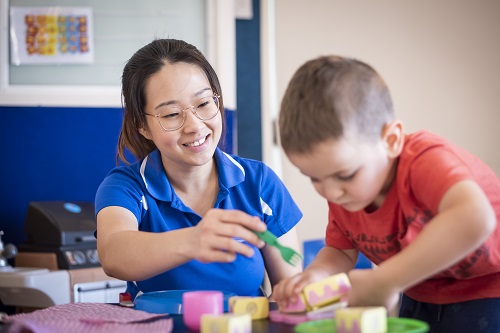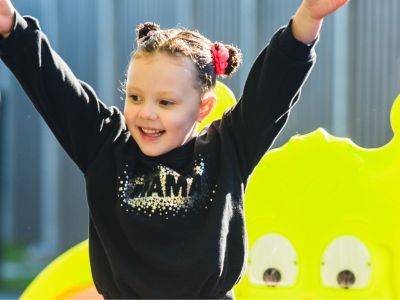
Did you know that there is no official industry day recognising behaviour therapy and behaviour therapists? So, this year, we’ve created a day to recognise the AEIOU Behaviour Therapist team—on Friday 20 March. There are days of celebration for each discipline and we take this as an opportunity to shine the spotlight on the experience and expertise of our staff, for who they are individually and what they each bring to our rounded team who all play an invaluable role in the shared delivery of early intervention at AEIOU.
So, happy first Behaviour Therapy Day at AEIOU! Being a ‘behaviour therapist’ is not a household name (or career!) you usually hear shared around the dinner table but, here at AEIOU, it is a vital aspect of our program every day. At each centre, AEIOU’s behaviour therapists work with children in every room, as part of our transdisciplinary team.
If you’re wondering what a transdisciplinary team is, you’re not alone. Basically, it is a team who come together with various skills to share the responsibility of planning, evaluating and implementing each child’s individual plan. For us at AEIOU, that looks like a team that includes a mix of people, such as behaviour therapists, occupational therapists and speech pathologists alongside teachers and educators. Each role is highly skilled and valued, and we work within this framework to apply evidence-based practice and supports from each discipline in the design and delivery of each child’s daily program.
So, what are some of the behaviour therapy aspects of our program?
- We support how children can access learning by working to reduce their barriers to learning (e.g. attention span, reduction of behaviours of concern, tolerance to adult instruction)
- Developing a child’s motivation for learning through reinforcement and building rapport
- Educating team members on strategies to support skill development and reduction of behaviours of concern
- Educating parents and carers
One of the best first steps in Behaviour Therapy is to build a relationship with the child – think playing with children and having lots of fun! For many of our families, it can be difficult to play and engage with their child in a way many people take for granted. They may not get the response and interest they expected to experience and this can cause a sense of despair and anxiety. If you’re feeling this way, you are not alone! Children with autism can build many loving and great relationships, but sometimes this interaction may need to be developed in a different way and may take longer than it does with a typically developing child.
Below is how we as Behaviour Therapists start build and maintain this relationship with children when they start at AEIOU. Some of it may sound like common sense; however, these are things that can easily be lost when considering the reality and the stress of daily family life.
- Have fun – and take their lead! Play how the child wants to play (e.g. if a child likes to build towers and knock them over then build towers and knock them over; if they like tickles, give them tickles; if they like to line things up, then line them up also).
- Pair yourself with things they love – Bring more of what they like when you are there or a better quality version of what they have access to every day. Make the things they are playing with even better when they are engaging in them with someone else.
- Be flexible – How this relationship develops with one child (e.g. giving lots of tickles) may not work for another child (e.g. may prefer not to be touched). Sometimes this means we have to change how we would naturally interact with our children. Remember, some people like coriander and some people say it tastes like soap!
- Do not have expectations – This is possibly the hardest thing to avoid doing. Naturally, as adults, we provide instructions (or demands) to children. When building a relationship, the initial aim is to be fun and engaging.
We love the opportunity to make a genuine connection with each of the children in our care. By helping to reduce some of the social or learning barriers children with autism experience, we get to see the way each child shines in their own individual way, and there’s nothing better than that.


































